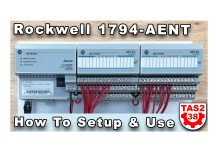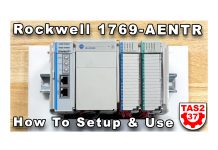
In today’s edition of “Insight’s Inbox” we answer a reader’s question about what we think would be the best PLC to use in a college course.
Reader Question:
My professor reached out to me to ask which PLC I would recommend he purchase with some school funds he had left over, and I wanted to get your opinion?
Insight’s Answer:
Great to hear your professor is looking to add PLCs to his curriculum!
The first option is the ultimate budget option: The Allen-Bradley MicroLogix 1000.
I go into the gory details of why I recommend this Allen-Bradley PLC to beginners in the below article, but in short it programs like most other A-B PLCs, is inexpensive at ~$150, can be programmed with fee software, and even has a free emulator:
- https://theautomationblog.com/beginners-plc/
- http://www.theautomationblog.com/episode-26-beginners-plc/
More information about the MicroLogix 1000 and its free software can be found in the below articles:
- https://theautomationblog.com/tag/micrologix-1000/
- http://www.theautomationblog.com/tag/micrologix-1000/
- https://theautomationblog.com/free-micrologix-1000-programming-software/
- https://theautomationblog.com/how-to-get-a-free-copy-of-rslogix-emulate-500/
The $150 model has 6 inputs and 4 outputs and a Mini Din serial port for programming. Low cost programming cables for it can be found here:
I also know someone who sells a very affordable training course that would get your professor up to speed quickly:
The second option is like the first but with a more powerful Ethernet processor: The Allen-Bradley MicroLogix 1100
Upgrade from the 1000 to the 1100 and you will be spending roughly $500 per PLC, but you’ll also be getting Ethernet communications, online editing, Floating Point and Long Integers, a well as expansion I/O capabilities.
They also program with the free software mentioned above, and more info about that can be found below:
- https://theautomationblog.com/tag/micrologix-1100/
- http://www.theautomationblog.com/tag/micrologix-1100/
Note before discussion some more expensive options:
Before going into the more expensive options, I would like to note that the more money you have, the more the Educational Program from Rockwell makes sense.
For around $200 you get a one year, one license toolkit of all their software along with 8-5 M-F tech support (for the instructor.)
But the best part is you get a crazy good hardware and software discount!
The down side? You have to call you local rep and fill in a form (i.e. no big deal!) It can also take a couple of weeks to process.
More info on this program can be found below:
For those with a larger budget, I would recommend the Allen-Bradley CompactLogix line
Specifically the CompactLogix L1 family, which likely will run you $1400 a unit, and the lowest cost software to program it (assuming you are not in the EDU program getting an 80% discount) is going to run around $900 per seat.
Your local distributor is likely to be able to order “Starter Packs” that combine the software and hardware for a reduced price.
More info below:
- http://www.theautomationblog.com/season-2-episode-23-compactlogix-1769-l16er/
- https://theautomationblog.com/compactlogix-and-controllogix/
- https://theautomationblog.com/what-software-do-i-need-to-program-compactlogix-or-controllogix/
A word on Input and Output Devices
The hot new thing is Ethernet/IP, and everyone is putting VFD’s, Valve Stacks, and all kinds of I/O devices on Ethernet, including remote racks of I/O.
So if you had a larger budget and are purchasing a CompactLogix, I would recommend also getting an A-B PowerFlex 525 VFD, Point I/O remote I/O, and an SMC valve stack.
As far as digital I/O, I recommend diffused and retro-reflective photo eyes, inductive proxes, 22mm push buttons and pilot lights, as well as assorted relays and contactors/motor starters.
For analog I/O, I would try and stay with 4-20ma in and out, with the most common devices having to do with speed, position, temperature and flow control.
Update: If you have your own question you’d like to ask, please post it as a comment on a related post here at TheAutomationBlog.com
Hope this helps!
Until next time, Peace ✌️
If you enjoyed this content, please give it a Like, and consider Sharing a link to it as that is the best way for us to grow our audience, which in turn allows us to produce more content 🙂
Shawn M Tierney
Technology Enthusiast & Content Creator
Support our work and gain access to hundreds members only articles and videos by becoming a member at The Automation Blog or on YouTube. You’ll also find all of my affordable PLC, HMI, and SCADA courses at TheAutomationSchool.com.
- FactoryTalk Design Workbench First Look, CCW Comparison - December 19, 2025
- Drew Allen of Grace Technologies on Automation, Safety, and More (P256) - December 17, 2025
- Robotics in Warehouse Automation with Erik Nieves of Plus One Robotics (P255) - December 10, 2025

Discover more from The Automation Blog
Subscribe to get the latest posts sent to your email.




Micro series PLCs would allow people to use ladder, ST, and FBD and a low cost per each unit. 820 and 850 have ethernet.
As for valves on ethernet I’ve got my eye on Numatics G3. I want to use it on a project, but the right project hasn’t come across my desk yet.
Good morning Jeff,
I agree the Micro800 line is a good value, but the instruction set is quite different from other A-B PLCs, and it doesn’t have a free emulator like the MicroLogix does, which are the two main reasons I don’t recommend them for first time users.
However, anyone who teaches themselves using the free RSLogix Micro Starter Lite and Emulate 500 would feel right at home with a SLC-500, and should have no problems with a PLC except for the I/O addressing lol.
Plus, instructions like the XIC, OTE, TON, CTU, and RES look nearly identical in Studio 5000, so it helps a little there too.
PS – Would love to hear about your first experience with the G3 when you get an app to use it on,
Sincerely,
Shawn Tierney